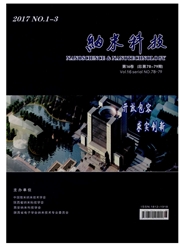

 中文摘要:
中文摘要:
以Na2CO3、ZnSO4和ZrOCl2·8H2O为原料,采用直接沉淀法制备了纯ZnO和掺锆ZnO的纳米粉体,并用XRD、FT-IR、UV-Vis、SEM和TEM等表征手段进行表征,用紫外灯作为光源,亚甲基蓝溶液为光催化反应模型降解物,研究了ZnO和掺锆ZnO纳米粉体的光催化性能,并考察了前驱体煅烧温度与时间、掺锆量以及催化剂加入量等因素对降解率的影响,结果表明,煅烧温度为700℃时,相比纯ZnO掺杂锆的ZnO晶粒结晶良好,样品粒度分布更均匀,粒径变小,且掺锆的ZnO光催化活性高。当掺锆量为1%(摩尔比)时,光催化性能最好,加入催化剂量为0.8g.dm^-3,光降解时间为1h时,对亚甲基蓝溶液的降解率可达到98.65%。
 英文摘要:
英文摘要:
Pure zinc oxide(ZnO) and zirconium(Zr)-doped ZnO nanoparticles have been synthesized by directly precipiting by Na2CO3, ZnSO4 and ZrOCl2.8H2O as raw materials. The samples were characterized by XRD,FT-IR,UV-Vis, SEM and TEM. The photoeatalytic performance of different ZnO samples were carried out to degrade methylene blue solution under ultraviolet illumination. The effects of calcining temperature, ealeining time, amount of doping Zr and content of catalyst on the degradation rate of methylene blue were investigated. The results indicated that when the calcination tem- perature was 700℃, comparing with the pure ZnO samples, Zr-doping ZnO can improved the photaeatalytic performance and the uniformity of its particles. And the photoeatalytic degradation ratio can be up to about 98.65% for 1 h by the amount of 0.8 g.dm^-3 ZnO doped with 1.0% (molar ratio) Zirconium.
 同期刊论文项目
同期刊论文项目
 同项目期刊论文
同项目期刊论文
 Structural, electronic, and magnetic properties of heterofullerene C58Si with odd number of atoms an
Structural, electronic, and magnetic properties of heterofullerene C58Si with odd number of atoms an Interactions Between an Anionic Fluorosurfactant and a PEO-PPO-PEO Triblock Copolymer in Aqueous Sol
Interactions Between an Anionic Fluorosurfactant and a PEO-PPO-PEO Triblock Copolymer in Aqueous Sol Photoluminescence Enhancement of Porous Silicon by Adding Titanium Sol during Electrochemically Etch
Photoluminescence Enhancement of Porous Silicon by Adding Titanium Sol during Electrochemically Etch 期刊信息
期刊信息
